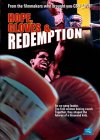| Reviews & Columns |
|
Reviews DVD TV on DVD Blu-ray 4K UHD International DVDs In Theaters Reviews by Studio Video Games Features Collector Series DVDs Easter Egg Database Interviews DVD Talk Radio Feature Articles Columns Anime Talk DVD Savant Horror DVDs The M.O.D. Squad Art House HD Talk Silent DVD
|
DVD Talk Forum |
|
|
| Resources |
|
DVD Price Search Customer Service #'s RCE Info Links |
|
Columns
|
|
|
Hope, Gloves and Redemption: The Story of Mickey and Negra Rosario
The footage eventually became 9/11, an unflinching 2002 documentary that first aired on CBS. The Naudets, who co-directed the finished product with James Hanlon (a New York firefighter-turned-actor), were rightly praised for keeping their film resolutely apolitical, avoiding the fair weather patriotism and knee-jerk flag-waving that followed that tragedy.
Prior to 9/11, the Naudet's only other credit had been Hope, Gloves and Redemption: The Story of Mickey and Negra Rosario, a 1999 feature-length documentary shot on video. It promises something along the lines of an amateur boxing circuit version of When We Were Kings (1996). Unfortunately, it is as ordinary as 9/11 was extraordinary.
At the center of the picture are Mickey and Negra Rosario, sixty-something, husband and wife boxing coaches at the Thomas Jefferson Recreation Center in Spanish Harlem. Mickey seems to have virtually been the inspiration for Bernardo in West Side Story. A Puerto Rican immigrate, he was a smoothly handsome gang leader in the mid-1950s and virtually owned the neighborhood. He chose joining the army in lieu of serving time in jail and later became a professional boxer. He eventually became a boxing coach and soon his equally strong, ambitious wife Negra joined him in the ring, becoming the first American woman boxing coach.
It's hard not to admire the couple's talent, professional and personal achievement, and simple good judgement. The film, however, is as predictable as a Rocky sequel. The Rosarios aim is to get troubled youth off the streets, away from gangs and drugs, to offer them the kind of emotional support and discipline denied them at home, to act as surrogate parents for kids who have none.
Not surprisingly, the film also focuses on a cross section of young hopefuls looking "for a way out ... an identity" as they train for the Junior Olympics and, especially, the Golden Gloves competition, the Super Bowl of the amateur circuit. There's ex-con Quinn, female boxer Evelyn, and former gang-banger and drug abuser Rudy, among others, who express their hopes, fears, and personal tragedies.
Hope, Gloves and Redemption is admirable in its ambitions, but not particularly compelling. For starters, the documentary seems to lack focus. Despite the subtitle, the Rosario's story plays as if it was the original focus as the film went into production. When the Naudets realized Mickey and Negra, fine human beings though they may be, didn't have much a story, they padded it with other material. Equal weight is given to other boxers at the club, and two climatic fights at the Golden Gloves competition, by which time the Rosarios are pretty much relegated to the sidelines.
The fights themselves are exciting, knowing what's at stake for each amateur boxer. The fights are predictably unpredictable, with one ending in a surprising way. Fortunately for the Naudets, each match is stylistically different, with one messy and brutal, the other fast-paced and polished.
Probably the best thing about the documentary is how well it captures the milieu of the gyms, the streets of upper Manhattan, and especially the locker rooms. (The boxers joke with one another until they're matched up, then a grim, game-face silence permeates the room, almost like Kirk Douglas and Woody Strode awaiting death in Spartacus). Little details are captured, like the way Mickey and Negra wrap gauze around the fighter's hands before putting the gloves on. Mostly though, Hope, Gloves and Redemption, as a well-meaning film about troubled youth finding a sense of self through amateur boxing, is exactly what you'd imagine such a film to be, and not much more.
Video & Audio
There's nothing to write home about with Pathfinder's presentation of Hope, Gloves and Redemption. The film was shot on video, using a DV Sony vx1000 camera. The 4:3 image is fine if unexceptional, as is the stereo soundtrack, replete with its rap score. The only Extras are bios of the Naudets and a video liner notes on the making of the film.
Stuart Galbraith IV is a Los Angeles and Kyoto-based film historian whose work includes The Emperor and the Wolf -- The Lives and Films of Akira Kurosawa and Toshiro Mifune. He is presently writing a new book on Japanese cinema for Taschen.
|
| Popular Reviews |
| Sponsored Links |
|
|
| Sponsored Links |
|
|
| Release List | Reviews | Shop | Newsletter | Forum | DVD Giveaways | Blu-Ray | Advertise |
|
Copyright 2024 DVDTalk.com All Rights Reserved. Legal Info, Privacy Policy, Terms of Use,
Manage Preferences,
Your Privacy Choices | |||||||













